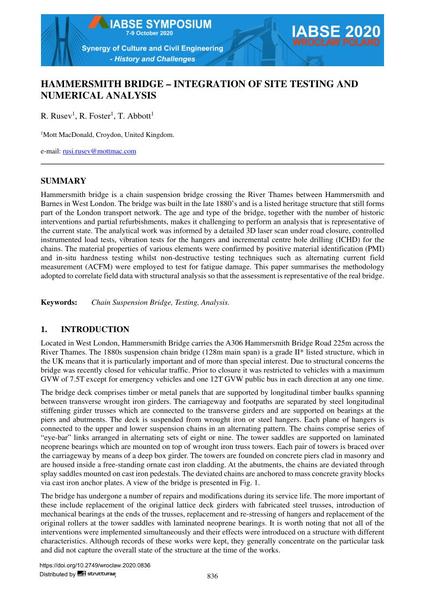Hammersmith Bridge – Integration of Site Testing and Numerical Analysis

|
|
|||||||||||
Bibliografische Angaben
| Autor(en): |
R. Rusev
R. Foster T. Abbott |
||||
|---|---|---|---|---|---|
| Medium: | Tagungsbeitrag | ||||
| Sprache(n): | Englisch | ||||
| Tagung: | IABSE Symposium: Synergy of Culture and Civil Engineering – History and Challenges, Wrocław, Poland, 7-9 October 2020 | ||||
| Veröffentlicht in: | IABSE Symposium Wroclaw 2020 | ||||
|
|||||
| Seite(n): | 836-843 | ||||
| Anzahl der Seiten (im PDF): | 8 | ||||
| Jahr: | 2020 | ||||
| DOI: | 10.2749/wroclaw.2020.0836 | ||||
| Abstrakt: |
Hammersmith bridge is a chain suspension bridge crossing the River Thames between Hammersmith and Barnes in West London. The bridge was built in the late 1880’s and is a listed heritage structure that still forms part of the London transport network. The age and type of the bridge, together with the number of historic interventions and partial refurbishments, makes it challenging to perform an analysis that is representative of the current state. The analytical work was informed by a detailed 3D laser scan under road closure, controlled instrumented load tests, vibration tests for the hangers and incremental centre hole drilling (ICHD) for the chains. The material properties of various elements were confirmed by positive material identification (PMI) and in-situ hardness testing whilst non-destructive testing techniques such as alternating current field measurement (ACFM) were employed to test for fatigue damage. This paper summarises the methodology adopted to correlate field data with structural analysis so that the assessment is representative of the real bridge. |
||||
| Stichwörter: |
Analyse
|
||||
